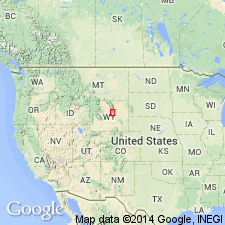
- Usage in publication:
-
- Rusty Beds Member
- Modifications:
-
- Revised
- Dominant lithology:
-
- Shale
- Sandstone
- Siltstone
- AAPG geologic province:
-
- Bighorn basin
Summary:
Pg. 1659, 1669-1670. Rusty Beds Member of Thermopolis Shale. It has been informally known as "Rusty Beds" for a long time, and term is ingrained in the literature. Unit has been placed in uppermost Cloverly Formation or lowermost Thermopolis by previous investigators. It is here proposed that it be formally named Rusty Beds member of the Thermopolis. Consists of shale with minor sandstone and siltstone. Shale is dark gray to black, silty, paper-thin to laminated. Yellow and rusty staining is common along bedding surfaces and fractures. Sandstone and siltstone occur as interbeds and lentils. Basal few inches of member contains medium to very coarse grains, and even pebbles, which seem to have been derived from the underlying Cloverly. Total thickness 71 to 106 feet, averages 87 feet. Age is Early Cretaceous.
[Notable exposures in southern Big Horn Mountains of WY.]
Source: Publication.
For more information, please contact Nancy Stamm, Geologic Names Committee Secretary.
Asterisk (*) indicates published by U.S. Geological Survey authors.
"No current usage" (†) implies that a name has been abandoned or has fallen into disuse. Former usage and, if known, replacement name given in parentheses ( ).
Slash (/) indicates name conflicts with nomenclatural guidelines (CSN, 1933; ACSN, 1961, 1970; NACSN, 1983, 2005, 2021). May be explained within brackets ([ ]).

